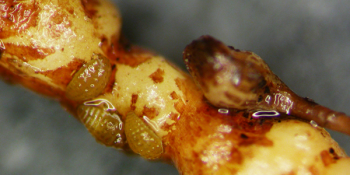Four More Colorado Vineyards Test Positive for Phylloxera Insect
BROOMFIELD, Colo. – In November 2016, the Colorado Department announced that an insect capable of damaging Colorado’s wine grape crop was confirmed in Mesa County; since then, an additional three vineyards have tested positive for the insect. US Department of Agriculture’s Agricultural Research Service entomologists identified grapevine phylloxera (Daktulosphaira vitifoliae) on Vitis vinifera grapevines in the Grand Valley American Viticultural Area (AVA), which is a federally designated grape production area in western Colorado.
In its full life cycle, phylloxera can take multiple forms. The most serious and damaging form, which was recently discovered in Mesa county, feeds on roots of grape plants. It can damage the plant by disrupting water and nutrient flow. Initially, infested plants appear weakened, stunted, and with leaves lighter in color which may look like they are suffering from a nutrient deficiency. In addition, phylloxera can live out another stage of its life on grapevine leaves. This less serious form feeds on leaves that causes leaf galls to develop, but generally not on V. vinifera.
Our priority right now is to continue surveying vineyards to see how widespread this infestation is and to encourage Colorado’s grape growers to practice biosecurity methods that can help protect their crop said Laura Pottorff, CDA’s Nursery and Phytosanitary program manager.
-
Watch plants for symptoms of chlorotic leaves, stunting, poor vigor, and other symptoms that mimic nutritional deficiencies. If detected roots of plants must be sampled for presence of phylloxera.
- Contact CSU- Western Colorado Research Center (970-434-3264) or CDA (303-869-9070) to take part in survey of your vineyard.
- All harvesting and cultivation equipment should be power washed or sanitized between fields.
- When purchasing grape nursery stock from any nursery, request that the plants be hot water dipped prior to shipment. If nurseries are not able to hot water dip vines prior to shipment, then growers themselves need to hot water dip vines prior to planting. For details of this procedure, contact CDA, CSU or the Colorado Wine Industry Development Board (CWIDB).
- Examine and inspect all new nursery stock prior to planting. Contact the Colorado Department of Agriculture if you would like to request assistance with inspection of incoming nursery stock. 303-869-9070
- Consider use of grafted grape nursery stock for all susceptible cultivars, including all those of Vitis vinifera origin.
Phylloxera is found throughout the United States. It has also been present throughout Europe since the 19th Century as well as in California since the early 20th Century. Although its discovery will cause our grape-growers to adopt new biosecurity measures to limit its spread and impact, Colorado will continue to produce world-class wines just as they continue to do in Europe and California said Doug Caskey, Colorado Department of Agriculture’s Executive Director for the CWIDB

Leave a Reply